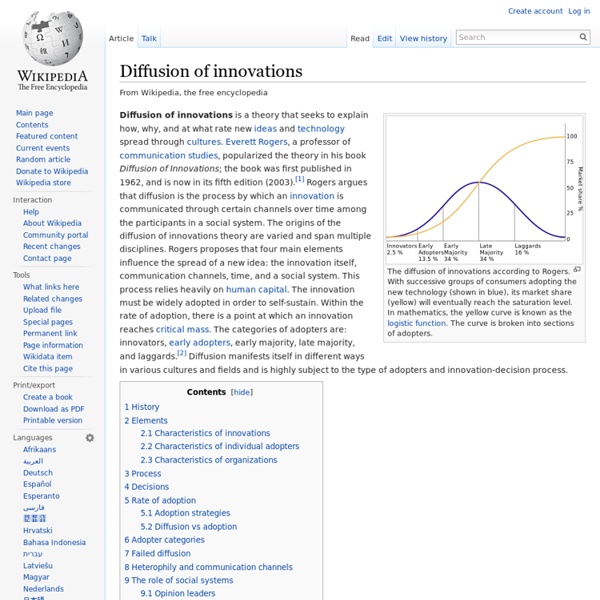Diffusion of Innovations, 5th Edition (9780743222099): Everett M. Rogers, Everett Rogers: Gateway
Uses and gratifications theory - Wikipedia, the free encyclopedi
Uses and gratifications theory (UGT) is an approach to understanding why and how people actively seek out specific media to satisfy specific needs. UGT is an audience-centered approach to understanding mass communication.[1] Diverging from other media effect theories that question "what does media do to people?", UGT focuses on "what do people do with media?"[2] This communication theory is positivistic in its approach, based in the socio-psychological communication tradition, and focuses on communication at the mass media scale.[3] The driving question of UGT is: Why do people use media and what do they use them for? UGT discusses how users deliberately choose media that will satisfy given needs and allow one to enhance knowledge, relaxation, social interactions/companionship, diversion, or escape.[4][5][6] It assumes that audience members are not passive consumers of media. Uses and gratifications approach[edit] Assumptions of the theory[edit] Heuristic approach of UGT[edit] History[edit]
Technology life cycle
The typical life-cycle of a manufacturing process or production system from the stages of its initial conception to its culmination as either a technique or procedure of common practice or to its demise. The Y-axis of the diagram shows the business gain to the proprietor of the technology while the X-axis traces its lifetime. The technology life-cycle (TLC) describes the commercial gain of a product through the expense of research and development phase, and the financial return during its "vital life". Some technologies, such as steel, paper or cement manufacturing, have a long lifespan (with minor variations in technology incorporated with time) whilst in other cases, such as electronic or pharmaceutical products, the lifespan may be quite short. The TLC associated with a product or technological service is different from product life-cycle (PLC) dealt with in product life-cycle management. The four phases of the technology life-cycle[edit] The TLC may be seen as composed of four phases:
Literacy
Global adult literacy. World illiteracy halved between 1970 and 2005. The United Nations Educational, Scientific and Cultural Organization (UNESCO) defines literacy as the "ability to identify, understand, interpret, create, communicate and compute, using printed and written materials associated with varying contexts. Literacy involves a continuum of learning in enabling individuals to achieve their goals, to develop their knowledge and potential, and to participate fully in their community and wider society".[4] History[edit] Illiteracy rate in France in the 18th and 19th centuries Origins of literacy[edit] Literacy is thought to have first emerged with the development of numeracy and computational devices as early as 8,000 BCE. The earliest forms of written communication originated in Sumer, located in southern Mesopotamia in 8000 BCE. Egyptian hieroglyphs emerged from 3300-3100 BCE and depicted royal iconography that emphasized power amongst other elites. Origins of the alphabet[edit]
From creation myth to the reality of innovation today
On the surface, Malcolm Gladwell’s latest article for The New Yorker, “Creation Myth: Xerox PARC, Apple, and the truth about innovation“, is a story about the mouse and how inventions travel – and evolve – across time and place. But examined more deeply, the article is really about the factors that determine whether you end up with an invention or an innovation. Simply put: “invention” is the manifestation of an idea or creation of something new. It doesn’t become an “innovation” until it’s applied successfully in practice – i.e., it reaches the market and impacts people’s lives. The story of PARC – and for that matter, any other innovative company – is indeed a mix of hopeful inventions, world-changing innovations, and missed opportunities, as Gladwell observes. On the challenges of invention and innovation 1. 2. 3. 4. 5. A note on the popular story of the mouse Speaking of the “expert mind”… There’s a nuance that’s often forgotten in popular retellings of the story of the mouse.
FEED: The Razorfish Digital Brand Experience Report 2009 Key Fin
Research and development
Cycle of research and development The research and development (R&D, also called research and technical development or research and technological development, RTD in Europe) is a specific group of activities within a business. The activities that are classified as R&D differ from company to company, but there are two primary models. Background[edit] New product design and development is more often than not a crucial factor in the survival of a company. A system driven by marketing is one that puts the customer needs first, and only produces goods that are known to sell. In general, R&D activities are conducted by specialized units or centers belonging to a company, or can be out-sourced to a contract research organization, universities, or state agencies. Statistics on organizations devoted to "R&D" may express the state of an industry, the degree of competition or the lure of progress. Business[edit] Present-day R&D is a core part of the modern business world. United States[edit]
El Blog para aprender inglés
How any business can innovate like Apple
by Josh Bernoff Yeah, right. Innovate like Apple. You can do it. One of the smartest guys I know is James McQuivey, who works with me at Forrester Research. It's very human to think about the linear evolution that created a product like the iPad. It's also wrong. In fact, breakthrough new products come about from a combination of forces. You can do this too. Exploit the adjacent possible. It's not that easy, you say. Photo by Grant Robertson via Flickr.



